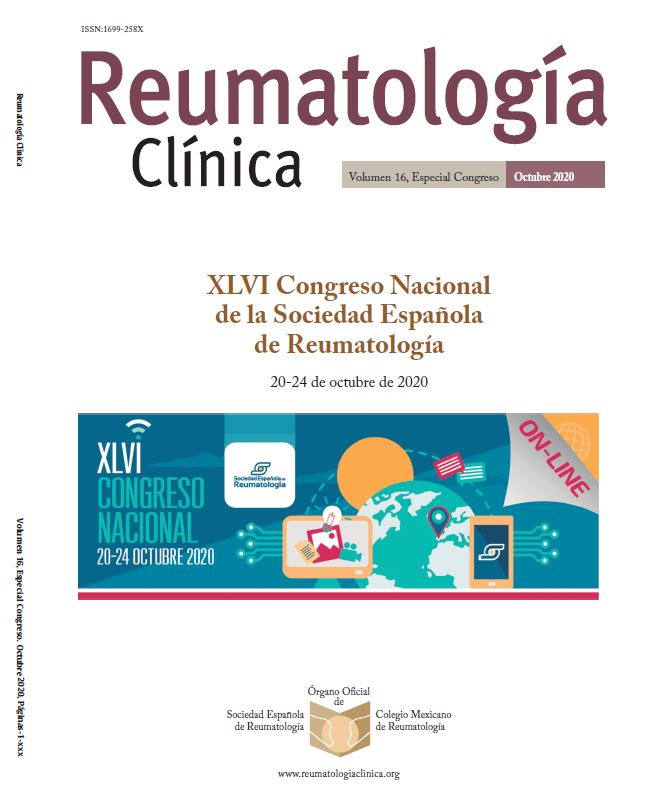P085 - Is the Therapeutic Target Achievement Increasing Over Time in Patients with Psoriatic Arthritis Starting Biological Therapy? Data from 15 Years
Hospital La Paz. Idipaz. Madrid.
Introduction: Treatment in psoriatic arthritis (PsA) has undergone a major revolution in recent years, with the development of new targets and molecules. Despite these advances, data from clinical practice demonstrating a change in management success are scarce.
Objectives: To evaluate if the proportion of patients (pts) with PsA maintaining an acceptable medium-term control of the disease activity after starting a first biologic agent is increasing over time.
Methods: Prospective cohort including 101 patients (pts) with PsA starting a 1st biologic (TNF inhibitor, anti-IL 17 inhibitor) in a tertiary hospital between 2002-2018. Demographic, clinical and laboratory data were collected at the beginning of treatment. Disease activity indexes (ASDAS for axPsA and DAPSA for pPsA) were collected before starting biologic. six and twelve months later (baseline, 6m and 12m visit, respectively). Low disease activity (LDA) was defined as ASDAS < 2.1 (axPsA) and DAPSA ≤ 14 (pPsA). Three groups were established according to biologic initiation date: period 1 (p1) (between 2002-2007), (p2) 2008-2013 and (p3) 2014-2018. Each period had a minimum follow-up of 1 year for every patient. For each interval, the percentage of pts achieving persistent (at both follow-up visits) LDA was determined, as a marker of acceptable medium-term control of the disease. All collected variables were compared between groups by ANOVA and Chi-Squared test.
Results: Out of the 101 pts initiating biological therapy, 46% were males and 57% had peripheral PsA. At the biologic treatment start, mean ± SD age was 48.5 ± 12 years and disease duration was 9.9 ± 10 years. Biological therapies initiated included etanercept in 38% of pts, infliximab in 24%, adalimumab in 25%, golimumab in 7%, secukinumab in 3% and certolizumab in 3%. Stratified by time intervals, 36 (35.6%) pts started in p1, 36 (35.6%) in p2 and 29 (28.8%) in p3. Baseline characteristics of pts by periods are shown in Table 1. For patients in p3, compared to the previous intervals, a significant lower CRP (p = 0.03) and ESR (p = 0.004) were found at baseline, whereas there were no significant differences on baseline disease activity indices. Fifty-one (50%) pts achieved persistent-LDA after one year of starting biologic. Table 2 reports the total number of patients that were in LDA in all the visits in the 1st year, stratified per period of time and predominant manifestation. A lower percentage of patients in LDA (33% in p1 vs, 67% in p2 vs 52% in p3, p = 0.02) was found in the first interval, in comparison to the most recent periods. The difference in response between p2 and p3 is mainly due to the group of patients with pPsA, whereas the improvement in the group of patients with axPsA remains constant in both periods.
|
Table 1. Baseline patient’s characteristics by periods of time |
||||
|
2002-2007 (n = 36) |
2008-2013 (n = 36) |
2014-2018 (n = 29) |
p |
|
|
Characteristics at the beginning of biological therapy |
||||
|
Age at starting biologic, years (m ± SD) |
47 ± 11.5 |
49 ± 11.7 |
49 ± 14.3 |
0.7 |
|
Male sex, n (%) |
13 (36) |
23 (64) |
11 (38) |
< 0.05 |
|
Peripheral PsA, n (%) |
22 (61) |
16 (44) |
20(69) |
0.1 |
|
Erosions, n (%) |
14 (40) |
7 (20) |
7(20) |
0.1 |
|
Non-smokers, n (%) |
23 (64) |
25 (71) |
14 (50) |
0.2 |
|
BMI (m ± SD) |
27 ± 5.5 |
27 ± 4.2 |
25.5 ± 3.6 |
0.2 |
|
Disease duration, years (m ± SD) |
9.9 ± 10 |
8.8 ± 7.4 |
8.2 ± 10.0 |
0.8 |
|
RF +, n (%) |
3 (8) |
0 |
7 (10) |
0.2 |
|
HLA B27, n/N (%) |
3/8 (37) |
3/18 (16) |
4/18 (22) |
0.5 |
|
DMARDs (MTX/SSZ), n (%) |
26 (72) |
30 (83) |
24 (83) |
0.4 |
|
Methotrexate, n (%) |
22 (61) |
24 (67) |
20 (69) |
0.8 |
|
Sulfasalazine, n (%) |
12 (11) |
7 (19) |
7 (24) |
0.4 |
|
Baseline CRP (m ± SD) |
12.5 ± 15.8 |
12.8 ± 17.0 |
6.5 ± 5.9 |
< 0.05 |
|
Baseline ESR (m ± SD) |
31.5 ± 20.7 |
26.2 ± 22.0 |
15.6 ± 10.8 |
< 0.01 |
|
Baseline DAPSA (m ± SD) |
27.3 ± 11.2 |
24.7 ± 14.3 |
20 ± 14.3 |
0.2 |
|
Baseline ASDAS m ± SD) |
3.4 ± 1.0 |
3.1 ± 1.2 |
2.9 ± 1.1 |
0.4 |
|
Table 2. Patients achieving persistent-LDA during the 1st year of biological therapy, stratified by period of time and by type of disease |
|||
|
. |
Total |
pPsA |
axPsA |
|
2002-2007 |
33 |
36 |
28 |
|
2008-2013 |
67 |
75 |
55 |
|
2014-2018 |
52 |
50 |
55 |
Conclusions: The percentage of pts with PsA achieving LDA status after one year of initiating a biological therapy has substantially increased over time. A lower threshold of inflammation at biological therapy start and a broader spectrum of therapies might explain this better management on PsA.






